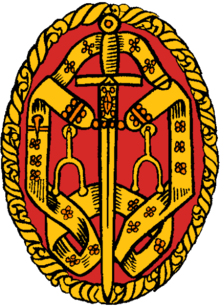Knight Bachelor
The dignity of Knight Bachelor is the basic and lowest rank of a man who has been knighted by the monarch but not as a member of one of the organised orders of chivalry; it is a part of the British honours system.[1] Knights Bachelor are the most ancient sort of British knight (the rank existed during the 13th century reign of King Henry III), but Knights Bachelor rank below knights of chivalric orders.
There is no female counterpart to Knight Bachelor. The lowest knightly honour that can be conferred upon a woman is Dame Commander of the Most Excellent Order of the British Empire (DBE), which is one rank higher than Knight Bachelor (being the female equivalent of KBE or Knight Commander of the Most Excellent Order of the British Empire, which is the next male knightly rank above Knight Bachelor). Also, foreigners are not created Knights Bachelor; instead they are generally made honorary KBEs.[2]
Criteria
Knighthood is usually conferred for public service; amongst its recipients are all male judges of Her Majesty's High Court of Justice in England. It is possible to be a Knight Bachelor and a junior member of an order of chivalry without being a knight of that order; this situation has become rather common, especially among those recognised for achievements in entertainment. For instance, Sir Ian Holm, Sir Michael Gambon, Sir Derek Jacobi, Sir Anthony Hopkins, Sir Elton John, Sir Michael Caine, Sir Barry Gibb and Sir Ian McKellen are Commanders of the Most Excellent Order of the British Empire (CBEs), as were Sir Bruce Forsyth, Sir Alan Bates, Sir Robert Helpmann, Sir Nigel Hawthorne, Sir John Mills, Sir John Hurt, Sir Christopher Lee, Sir Peter Ustinov, Sir Alec Guinness, Sir Richard Attenborough, Sir Michael Hordern and Sir Michael Redgrave. Sir Patrick Stewart, Sir Tom Jones and Sir Van Morrison are Officers of the Most Excellent Order of the British Empire (OBEs) while Sir Paul McCartney and Sir Richard Starkey (Ringo Starr) are Members of the Most Excellent Order of the British Empire (MBE). None of them would be entitled to use the honorific "Sir" by virtue of their membership of the order alone, but as they are all also Knights Bachelor, they are entitled to preface their names with that title.
Honorifics and post-nominals
Like other knights, Knights Bachelor are styled "Sir". Since they are not knights of any order of chivalry, there is no post-nominal associated with the honour.[3] When the style "Sir" is awkward or incomplete due to a subsequent appointment, recipients may sometimes use the word "Knight" or "Kt" (note the lowercase 't', which distinguishes it from "KT", the post-nominals of a Knight of the Thistle) after their name in formal documents to signify that they have the additional honour. This style is often adopted by Knights Bachelor who are also peers, baronets or knights of the various statutory orders.[4][5]
Insignia

Until 1926 Knights Bachelor had no insignia which they could wear, but in that year King George V issued a Warrant authorising the wearing of a badge on all appropriate occasions. The Knights Bachelor badge may be worn on all such occasions upon the left side of the coat or outer garment of those upon whom the degree of Knight Bachelor has been conferred. Measuring 23⁄8 inches in length and 13⁄8 inches in width, it is described in heraldic terms as follows:
Upon an oval medallion of vermilion, enclosed by a scroll a cross-hilted sword belted and sheathed, pommel upwards, between two spurs, rowels upwards, the whole set about with the sword belt, all gilt.
In 1974, Queen Elizabeth II issued a further warrant authorising the wearing on appropriate occasions of a neck badge, slightly smaller in size, and in miniature. In 1988 a new certificate of authentication, a knight's only personal documentation, was designed by the College of Arms.
Imperial Society of Knights Bachelor
The Imperial Society of Knights Bachelor was founded for the maintenance and consolidation of the Dignity of Knights Bachelor in 1908, and obtained official recognition from the Sovereign in 1912. The Society keeps records of all Knights Bachelor, in their interest.
See also
Notes
- ↑ "The British Honours System". www.churchill-society-london.org.uk. Retrieved 2017-05-23.
- ↑ "Imperial Society of Knights Bachelor". www.iskb.co.uk. Retrieved 2017-05-23.
- ↑ "Orders of Chivalry". British Government. Archived from the original on 19 August 2007. Retrieved 30 August 2007.
- ↑ "Form of address". Imperial Society of Knights Bachelor. Retrieved 17 April 2014.
- ↑ "Knight". Forms of address. Debrett's. Archived from the original on 5 April 2014. Retrieved 17 April 2014.
References
- Insignia of knights bachelor—Website of the Imperial Society of Knights Bachelor
- The UK Honours System—Website UK Government
- Debrett's
External links
